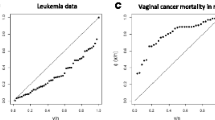Abstract
The hazard function describes the instantaneous rate of failure at a time t, given that the individual survives up to the instant t. The effect of the covariates produces a variation in the hazard function, hence a change point might occur. When dealing with survival analysis, it is of interest to identify where a change point has occurred. This paper proposes a new method for estimating the change point in the Cox proportional hazard model, which is based on maximum likelihood estimation combined with moments estimation (ME) and a numerical mehtod to minimize an objective function given by ME. The mean square error of the estimator is obtained by Monte Carlo simulation, considering different scenarios. For the purpose of studying the behavior of the proposed estimator in terms of its mean square error, a comparative study against a known method to estimate the change point is included. A real data application is also included.


Similar content being viewed by others
References
Chen J, Gupta AK (2001) On change point detection and estimation. Commun Stat Simul Comput 30(3):665–697
Chen J, Gupta AK (2012) Parametric statistical change point analysis with applications to genetics, medicine and finance, 2nd edn. Birkhäuser, Basel
Cox DR, Oakes D (1990) Analysis of survival data, 2nd edn. Chapman and Hall CRC, Cambridge
Engl N, Med J (1991) A controlled trial of interferon gamma to prevent infection in chronic granulomatous disease. Int Chronic 324:509–516
Fleming TR, Garrington DP (1991) Counting processes and survival analysis. Wiley, New York
Goodman M, Li Y, Tiwari R (2006) Survival analysis with change point hazard functions. Harvard Univ Biostat 40:1–31
Kleinbaum D, Klein M (2012) Survival analysis a self-learning text, 3rd edn. Springer, Berlin
Lawless JF (2003) Statistical models and methods for lifetime data, 2nd edn. Wiley, New York
Li Y, Qian L, Zhang W (2013) Estimation in a change-point hazard regression model with long-term survivors. Stat Prob Lett 83:1683–1691
Liang KY, Self SG, Liu X (1990) The Cox proportional hazard with change point an epidemiologic application. Biometrics 46(3):783–793
Liu M, Lu W, Shao Y (2008) A Monte Carlo approach for change point detection in the Cox proportional hazard model. Stat Med 27(19):3894–3909
Palmer P, Alfonso L (1993) Modelo de Regresión de Cox: ejemplo númerico del proceso de estimación de parámetros. Psicothema 5(2):387–402
Palmeros O, Villaseñor J, González E (2018) On computing estimates of a change point in the Weibull regression hazard model. J Appl Stat 45(4):642–648
Pons O (2003) Estimation in a Cox regression model with a change point according to a threshold in a covariate. Ann Stat 31(2):426–463
RCoreTeam (2020) R: a language and environment for statistical computing. R Foundation for Statistical Computing, Vienna
Salinas VH, Romeo JS, Pena A (2010) On Bayesian estimation of a survival curve: comparative study and examples. Comput Stat 25:376–389
Song E, Jaishankar G, Saleh H, Jithpratuck W, Shani R, Krishnaswamy G (2011) Chronic granulamatous disease: a review of the infectious and inflammatory complications. Clin Mol Allergy 9:10
Sullivan F (1993) Nonparametric estimation in the Cox model. Ann Stat 21(1):124–145
Ying Z, Lei H, Jian H (2010) A Spline-based semiparametric maximum likelihood estimation method for the Cox model with interval-censored data. Scand J Stat 37:338–354
Acknowledgements
The authors wish to express their sincere thanks to all reviewers of the original manuscript for their comments and suggestions, which helped to improve considerably the presentation of this manuscript. The authors also thank E. González-Estrada for her support in programming.
Author information
Authors and Affiliations
Corresponding author
Additional information
Publisher's Note
Springer Nature remains neutral with regard to jurisdictional claims in published maps and institutional affiliations.
Rights and permissions
About this article
Cite this article
Arenas, G.Y., Villaseñor, J.A., Palmeros, O. et al. A computational method for estimating a change point in the Cox hazard model. Comput Stat 36, 2491–2506 (2021). https://doi.org/10.1007/s00180-021-01087-2
Received:
Accepted:
Published:
Issue Date:
DOI: https://doi.org/10.1007/s00180-021-01087-2




